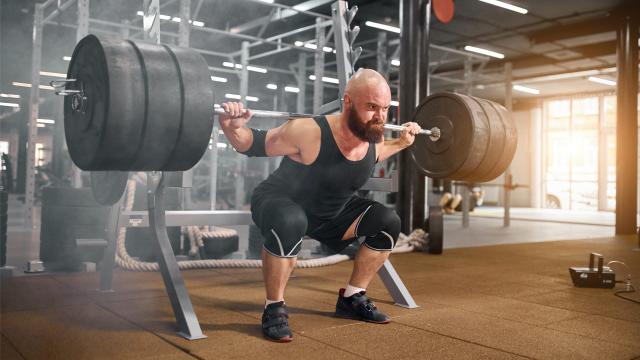Knee sleeves are beloved by many weightlifters, powerlifters, and other strong people. But what are they really for? This is a surprisingly hard question to answer, and there was a point in my lifting career when I found myself confused about whether I needed to buy a pair.
What are knee sleeves?
First, let’s be clear about what knee sleeves are. They’re typically made of neoprene, seven millimetres thick (although thinner ones are available), and they slip onto your knees like, well, sleeves. You buy them from specialty strength supply companies, usually, like SBD or Rehband. They’re not the same thing as those braces with a hole in the front, and they’re not thin, sock-like compression sleeves.
Knee sleeves probably don’t prevent injury
Sometimes people will claim that knee sleeves help to prevent injury, but there’s no solid evidence to back up this claim — no studies that I could find compared injury rates over time between people who squat heavy while wearing knee sleeves and people who squat heavy without them. There are biomechanics studies that show that knees operate the same way with a sleeve on as without, and there are studies showing that people often say their knees feel better when they wear sleeves, but the injury data just doesn’t seem to be there.
It wouldn’t make much sense, anyway: what is seven millimetres of neoprene going to do if you’re putting enough force on your knee to injure it? People talk about “compression” and “support,” but a little neoprene hug isn’t going to “support” your knee if many hundreds of pounds of force come down on it in the wrong direction. (Football teams are beginning to learn that even their heavy-duty knee braces don’t seem to affect injury rates; it’s hard to imagine that knee sleeves can do what braces don’t.)
Knee sleeves don’t assist your squat by much
Let’s stop for a minute and contrast knee sleeves with knee wraps, which are different. Wraps look like long, skinny elastic bandages, and they’re used in some strength sports to increase the amount of weight you can lift in a squat or a squat-like motion. You wrap them tight — or, ideally, get a teammate or coach to wrap them tight — just before you waddle onto the platform. They resist the motion of your knees bending, which means that when you sit down into a squat, the wraps’ elasticity helps your knees to straighten. Knee wraps can definitely help you squat more weight, when properly used.
Knee sleeves aren’t that tight. They’re usually comfortable enough you can wear them for a whole practice, although some athletes say if you buy them a size or two too small, and squeeze yourself into them, that they give you a little boost in standing up a squat.
But not everybody wears super-tight knee sleeves, and it’s arguable whether the sleeves really do provide much assistance. One recent study found that people were able to squat very slightly more weight while wearing sleeves, but that tighter sleeves didn’t have an advantage over normally fitted ones. The researchers concluded that “the benefits of neoprene knee sleeves may therefore be due to compression-mediated enhancements in comfort, stability, or knee joint heat retention.”
By the way, don’t forget you can save on your next buy with one of our eBay discount codes.
Knee sleeves just feel good
Now we can get to the important part, the thing where anecdotes and data fully agree: knee sleeves make your knees feel good.
For months I asked my fellow lifters why they wore knee sleeves and never got any really great answers beyond that. Eventually I decided I’d just have to buy a pair to find out, so I measured my knees and bought the recommended size from Norse Fitness in 7mm.
I noticed the difference in my first workout: my knees had never felt bad, but with the sleeves on, they just felt better. Every now and then I’d feel a little stiffness or mild discomfort if I did a workout with a lot of deep (arse-to-grass) squats; with sleeves, that just completely stopped happening. I didn’t become able to lift more, I just felt better while I was doing it.
One hypothesis is that the sleeves keep your joints warm, and warm body parts tend to perform better than cold ones, which is part of the point of “warming up.” I don’t find that explanation particularly convincing; knee sleeves feel just as good to me in hot and in cold weather, and I felt the effects instantly rather than waiting for them to warm me up. But I can’t prove this either way.
Another is that compression is good for your tendons or muscles. While there is some research to support the idea that compression helps muscle recovery, that research usually has people wearing their compression gear for hours after a workout. Could compression be a factor here, perhaps just making things feel better? Perhaps!
Greg Nuckols has a hypothesis that the way the neoprene bunches up behind your knee relieves some of the pressure that your kneecap puts on your thigh bone. That sounds more reasonable to me than many of the other theories I’ve heard, but nobody knows for sure.
Whatever the reason, squats just feel better with knee sleeves than without. If you’ve never tried them, you might like how they feel, but don’t expect them to prevent injuries or add significant poundage to your squat.

Leave a Reply
You must be logged in to post a comment.